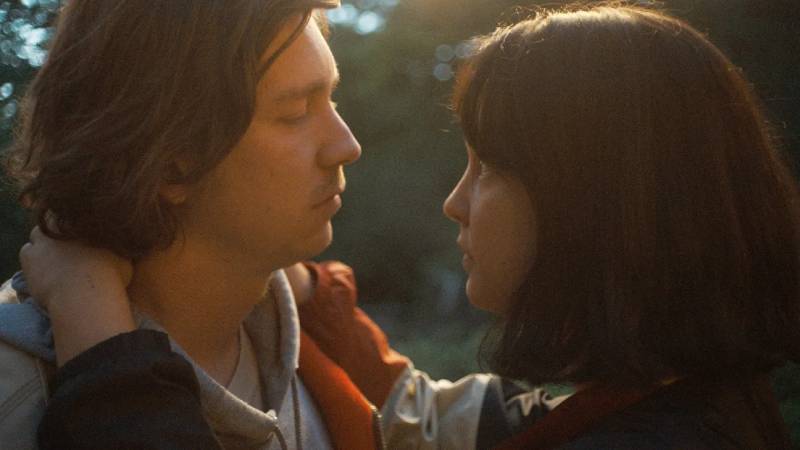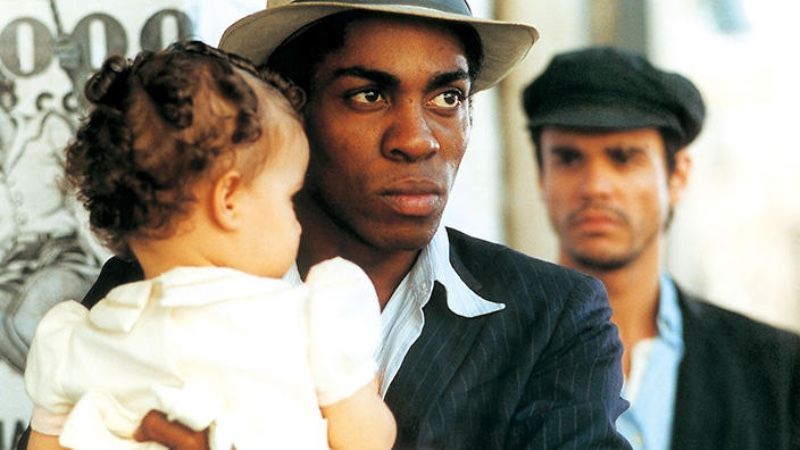A colourful sunset fills the Texas desert sky at the beginning of director Stuart Gatt’s directorial feature debut, Catching Dust. We can see the silhouetted trees and hear the dust blowing in the wind. Slowly, the montage sequence arrives at the abandoned Karl Madison commune, where a modern-day cowboy, armed with a rifle, runs his fingertips against a painting on the side of a cabin. He enters, and the window is lit up by the flashpoint of a gunshot.
The atmospheric and visually striking opening establishes the theme of isolation that runs throughout the story. Following the violence, there’s a deescalation as we’re introduced to Geena (Erin Moriarty) and her husband Clyde (Jai Courtney), a couple hiding out in a rundown trailer. They’re coy as to why they’re lying low, but Clyde is paranoid about anyone finding them. He refuses to let Geena accompany him into town, and while he disappears for hours on end, hunting and doing whatever else he does, she paints and draws.
She feels trapped, as though her life and any meaning have been stripped away in their hideout. She tells Clyde, “I need things that the desert can’t give me.” Her desire to return to the city is a source of tension and when New York couple Andy (Ryan Corr) and Amaya (Dina Shihabi), looking to hit the reset, arrive unexpectedly, the tension begins to escalate. Clyde’s paranoia and stubborn belief that nothing good can come of his new neighbours being there, threatens his own marriage and the commune’s peace.
The observational gaze of the film’s opening introduces the director’s observant eye. Gatt has a penchant for homing in on subtle and suggestive details, such as Amaya sharing a box of cakes, fresh from New York. It represents a stirring temptation and longing for something lost for Geena, who enjoys the rare, tasty treat. Clyde walks off, refusing a cake. It’s a reminder, that unlike her husband she doesn’t belong in the desert. Even the shots of the birds circling above the commune, increasing in number as the tensions escalate, serve as a metaphor.
Gatt has an eye for storytelling through these visual details. It shows his appreciation for visual language and its connotations, that elevates the film above its rudimentary origins of a familiar story told well. While Catching Dust is a meticulously crafted film, there’s an occasional scene where the symbolism feels laboured and intrusive, albeit this is a minor quibble.
There’s a welcome playfulness in the film, that teases familiar narrative patterns, and ultimately creates a messier take on relationships. Geena and Clyde’s marriage is not without a sensitivity and romance, but it’s suffocated by Clyde’s masculine dominance and strength. He’s a stubborn man, who fails to listen to Geena, believing he can convince her that they can be happy in the desert. He even begins building a new place for them, which emphasises, to the audience what Clyde fails to realise – Geena is like a pretty bird cooped up in a cage.
When Andy arrives, he and Geena unsurprisingly begin to bond. He says he hates his job in finance and teaches art classes two nights a week to stay sane. Aside from their shared passion for art, they can identify with one another’s incarceration – she in the desert, he in his workplace.
Early on, their affair feels set to be the driving narrative force of the film; two souls lost in their respective relationships who find a connection with another person. From a gentle love story set against a harsh physical and human landscape, Gatt pivots instead to a story that’s not dominated by the affair, instead focusing on the dynamic between the two couples and their individual relationships.
Throughout, Gatt leads us to misunderstand his characters. It’s not deceitful on his part, because the story encourages us to use our cineliterate minds to jump the gun and anticipate who they are, and what will happen. Catching Dust moves at a steady pace, allowing the relationships and tensions to develop towards its eventual climactic finale. As the characters are stripped back, we see the contradictions and Gatt’s intent to create a messier take on human nature. In the end, is it Gatt that’s manipulating us, or is it our assumptions? Either way, it’s an entertaining and engaging film.
Thematically, Catching Dust is about the failure of masculinity, and for its women, it’s a story of extremes where everything is too much – Geena is suffocated and Amaya is not loved enough. Gatt presents us with two flawed men, who in different ways hurt the women they claim to love. While one character feels more redeemable than the other, the end of the film leaves us feeling that we’ve witnessed a dramatic fallout.
Striking is we see what happens, but it’s a film that requires us to dig down into how we feel about these emotionally complicated characters. Themes and ideas about gender politics, freedom, fate and marital compromise are dredged up during their isolated ordeal, and tangled up in the messy interactions, they need to be untangled.
Catching Dust premieres at the 31st Raindance Film Festival.










